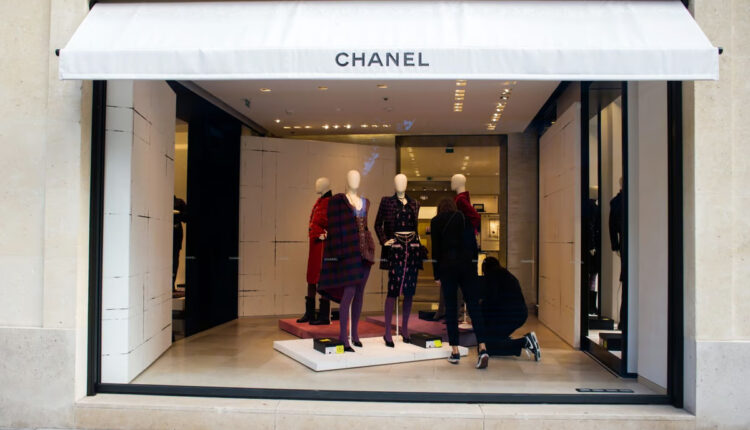
Fashionable Collaborators Of Murderous Regimes, Beware!
This story first appeared in NDTV.com
Are there any mitigating circumstances for the actions of the collaborators of a murderous regime?
In the graveyards of empires, the tombstones of collaborators invite scorn instead of awe or hatred. Collaborators do not start cults. Unless they are couturiers. A new series on Apple TV has attempted to expose the glamorous world, literally to its seams, by telling the tale of how some of the biggest names in luxury fashion today dealt with their biggest challenge: survival. The New Look transports the viewers to the world of haute couture legends-Coco Chanel, Christian Dior, Pierre Balmain, Cristobal Balenciaga-names that today mean little beyond the labels on clothes, accessories, cosmetics et al in countless influencer videos.
The companies bearing the names of these designers today are behemoths that bear little to no resemblance with their founders. Their customers care for the brand logo more than the creator. But when some of the leaders of the global fashion industry were struggling to keep afloat during the Nazi occupation of France in WWII, survival had a bloodier meaning than quarterly profits or year-on-year growth. This is the premise of the show-how the world of high fashion survived World War II.
Survival As Defence
However, when, and for whom, can survival become a defence plea in the court of moral judgment? Not many in the fashion world are aware that Elsa Schiaparelli, Christian Dior, Pierre Balmain, Cristobal Balenciaga and many other couturiers were dressing up the Nazis and their families when the Holocaust was in full swing. Hitler’s close aide, Heinrich Himmler, even tried his best to convince the fashion industry stalwarts in Paris to move to Germany. While French couturiers stayed put in Paris, they continued to create uniforms for German soldiers and dresses for their wives and girlfriends in return for concessions for raw material supplies that were getting increasingly difficult to procure. The Nazis’ dandyism kept the French fashion industry afloat, and couturiers alive. Coco Chanel, arrested for being a collaborator after the Allies won WWII, was unlikely to have stayed alive if the Nazis hadn’t taken a fancy to her personality. While she didn’t dress the Nazis, she certainly had dalliances with some of them.
Chanel, the woman who ruled the interwar sartorial world, has long been seen by cultural materialism theorists as the epitome of corrupt capitalism that flourishes at all costs. She was the prime reason why Simone de Beauvoir grew suspicious of fashion. In all these years of lambasting Chanel’s choices during the Nazi occupation years, a clear moral and ethical code ought to have emerged. Except there is none. Or if there is one, it is applied selectively. Worse, it is problematised further when profiteers begin to claim legitimacy.
Chanel And Galileo
Chanel wasn’t the only one making compromises, though she seems to have been disproportionately indicted. The high-voltage intellectual circuit comprising Jean-Paul Sartre, Cocteau, Christian Dior, Yves Montand, Maurice Chevalier, Pablo Picasso, Raoul Dufy, Henri Matisse, Pierre Bonnard, Georges Braque, Joan Miró, Wassily Kandinsky and Albert Camus et al kept the sparks flying while living and working in Paris during the German occupation. More than seventy galleries were allowed to be run in the capital of global arts, but only when all collaborating artists attested that they were not Jewish. Survival became the leitmotif of the Nazi years in Paris. Chanel ceased her business operations during WWII, but the Nazis recognised her as an influential woman who could prove useful to them.
At this point, Bertolt Brecht must be invoked. His play Life of Galileo deals with the subject of survival in the face of a murderous totalitarian regime. Brecht’s Galileo Galilee, the 16th-century Italian astronomer, is a hero despite his infamous recanting of his scientific theories after the Roman Inquisition threatened him with torture. Galileo kept the Inquisition happy only to buy time to disseminate his revolutionary ideas that undermined the authority of the Church. Chanel, similarly, had to keep the Nazis happy for survival. But is it a stretch to compare a woman who merely designed clothes and accessories with a scientist who influenced the likes of Newton and Einstein?
The Dignity Of Women
Through the chequered personal history of Chanel, two ideas shine the brightest: dignity and survival. Growing up in a Catholic orphanage after being abandoned by her father, struggling as an aspiring music hall performer, depending on the largesse of lovers to negotiate the hierarchy and social-cache-ridden milieu, and building a multi-million business empire through her creative vision that went against the established norms of the day, Chanel put a lot of currency on dignity. She saw the fragility of women like her and was determined to change the status quo. Her empire was built on the ethos of setting women free. Chanel’s designs, in her own words, “liberated the body, abandoned the waist, and created a new silhouette” to allow women to participate in the brave new world. Most importantly, she realised that in the world of men, women’s survival depended on how well they adapted masculine tastes and virtues in their daily lives.
But why are we talking about Chanel at all? Or other fashion designers, for that matter? Simply because collaborationism never goes out of fashion. When an oppressive regime takes over, those who are asked to bend begin to crawl. And many turncoats survive regime changes only because of their extraordinarily flexible spines. Lest they begin to seek vindication by quoting Chanel’s example, here is a not-so-gentle reminder: not everything deserves to survive. Art surely does, propaganda and profiteering do not. Yes, it’s all subjective. But, certainly, a dent in TRP or advertisement-driven incomes cannot be compared to the real threat to life posed by genocidal regimes.
